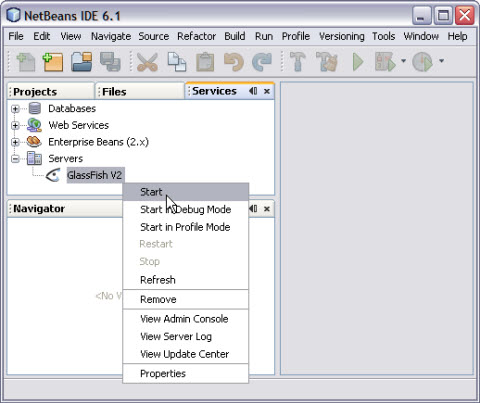
- CONNECT TO GLASSFISH SERVER NETBEANS JAVA INSTALL
- CONNECT TO GLASSFISH SERVER NETBEANS JAVA UPDATE
- CONNECT TO GLASSFISH SERVER NETBEANS JAVA SOFTWARE
- CONNECT TO GLASSFISH SERVER NETBEANS JAVA PASSWORD
6.4.2.1 To View the hello2 Web Module Using NetBeans IDE. 6.4 A Web Module That Uses Java Servlet Technology: The hello2 Example. 6.3.5.2 To Undeploy the hello1 Web Module Using Maven. 6.3.5.1 To Undeploy the hello1 Web Module Using NetBeans IDE. 6.3.5 Undeploying the hello1 Web Module. 6.3.4.1 Dynamic Reloading of Deployed Modules. 6.3.4 Running the Deployed hello1 Web Module. 6.3.3.3 To View Deployed Web Modules Using NetBeans IDE. 6.3.3.2 To View Deployed Web Modules Using the asadmin Command. 6.3.3.1 To View Deployed Web Modules Using the Administration Console. 6.3.2.2 To Build and Package the hello1 Web Module Using Maven. 6.3.2.1 To Build and Package the hello1 Web Module Using NetBeans IDE. 6.3.2 Packaging and Deploying the hello1 Web Module. 6.3.1 To View the hello1 Web Module Using NetBeans IDE. 6.3 A Web Module That Uses JavaServer Faces Technology: The hello1 Example. 6 Getting Started with Web Applications. 
5.4 Packaging Resource Adapter Archives.5.2.2 Packaging Enterprise Beans in WAR Modules.5.2.1 Packaging Enterprise Beans in EJB JAR Modules.4.3 The Main Differences between Resource Injection and Dependency Injection.3.3 Creating Resources Administratively.3.2 DataSource Objects and Connection Pools.2.9.2.1 To Debug an Application Using a Debugger.2.9.1.1 To Use the Administration Console Log Viewer.
CONNECT TO GLASSFISH SERVER NETBEANS JAVA UPDATE
2.8.2 To Update the Tutorial Using the Command Line. 2.8.1 To Update the Tutorial Using NetBeans IDE. 2.8 Getting the Latest Updates to the Tutorial. 2.7.1.2 Installing the Tutorial Archetypes Using Maven. 2.7.1.1 Installing the Tutorial Archetypes Using NetBeans IDE. 2.7.1 Installing the Tutorial Archetypes. 2.7 Java EE 7 Maven Archetypes in the Tutorial. 2.6 Tutorial Example Directory Structure. 2.4.1 To Start the Database Server Using NetBeans IDE. 2.4 Starting and Stopping the Java DB Server. 2.3.1 To Start the Administration Console Using NetBeans IDE. 2.3 Starting the Administration Console. 2.2.4 To Stop GlassFish Server Using the Command Line. 2.2.3 To Start GlassFish Server Using the Command Line. 2.2.2 To Stop GlassFish Server Using NetBeans IDE. 2.2.1 To Start GlassFish Server Using NetBeans IDE. 2.2 Starting and Stopping GlassFish Server. 2.1.4.2 To Add GlassFish Server as a Server Using NetBeans IDE. CONNECT TO GLASSFISH SERVER NETBEANS JAVA INSTALL
2.1.4.1 To Install NetBeans IDE without GlassFish Server. CONNECT TO GLASSFISH SERVER NETBEANS JAVA SOFTWARE
2.1.2 Java EE 7 Software Development Kit. 1.8.9 Common Annotations for the Java Platform. 1.8.8 Java Authentication and Authorization Service. 1.8.7 SOAP with Attachments API for Java.  1.8.5 Java Architecture for XML Binding. 1.8.2 Java Naming and Directory Interface API. 1.8 Java EE 7 APIs in the Java Platform, Standard Edition 7. 1.7.21 Batch Applications for the Java Platform. 1.7.20 Concurrency Utilities for Java EE.
1.8.5 Java Architecture for XML Binding. 1.8.2 Java Naming and Directory Interface API. 1.8 Java EE 7 APIs in the Java Platform, Standard Edition 7. 1.7.21 Batch Applications for the Java Platform. 1.7.20 Concurrency Utilities for Java EE.  1.7.17 Java Authentication Service Provider Interface for Containers. 1.7.16 Java Authorization Contract for Containers. 1.7.10 Contexts and Dependency Injection for Java EE. 1.7.8 Java API for RESTful Web Services. 1.7.5 JavaServer Pages Standard Tag Library. 1.6 Java EE Application Assembly and Deployment. 1.3.6 Enterprise Information System Tier. 1.3.3.4 The JavaBeans Component Architecture. 1.3 Distributed Multitiered Applications. Table of Contents Java Platform, Enterprise Edition: The Java EE Tutorial Expand | Collapse The output also goes into the server log, which is located in domain-dir /logs/server.log. The -verbose flag causes all logging and debugging output to appear on the terminal window or command prompt. With no arguments, the start-domain command initiates the default domain, which is domain1. The examples in this tutorial assume that you chose the default ports as well as the default user name and lack of password. You specify these values when you install GlassFish Server.
1.7.17 Java Authentication Service Provider Interface for Containers. 1.7.16 Java Authorization Contract for Containers. 1.7.10 Contexts and Dependency Injection for Java EE. 1.7.8 Java API for RESTful Web Services. 1.7.5 JavaServer Pages Standard Tag Library. 1.6 Java EE Application Assembly and Deployment. 1.3.6 Enterprise Information System Tier. 1.3.3.4 The JavaBeans Component Architecture. 1.3 Distributed Multitiered Applications. Table of Contents Java Platform, Enterprise Edition: The Java EE Tutorial Expand | Collapse The output also goes into the server log, which is located in domain-dir /logs/server.log. The -verbose flag causes all logging and debugging output to appear on the terminal window or command prompt. With no arguments, the start-domain command initiates the default domain, which is domain1. The examples in this tutorial assume that you chose the default ports as well as the default user name and lack of password. You specify these values when you install GlassFish Server. CONNECT TO GLASSFISH SERVER NETBEANS JAVA PASSWORD
The administration server's port number: The default is 4848.Īn administration user name and password: The default user name is admin, and by default no password is required.

The GlassFish Server port number: The default is 8080. The following elements are associated with a domain: To start GlassFish Server from the command line, open a terminal window or command prompt and execute the following: asadmin start-domain -verboseĪ domain is a set of one or more GlassFish Server instances managed by one administration server. 2.2.3 To Start GlassFish Server Using the Command Line








 0 kommentar(er)
0 kommentar(er)
